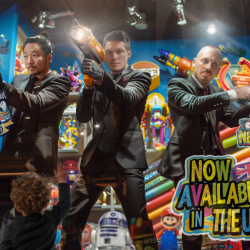‘The definition of insanity is doing the same thing over and over again, but expecting different results.’
Albert Einstein, theoretical physicist
Any brand would be forgiven for making this their mantra. But just when they begin to get comfortable with one strategy, external influences force a complete shake-up of the status quo. Online shopping became a manna from heaven during the pandemic for retailers and consumers alike — an opportunity to sate shopping desires when brick-and-mortar stores were off limits. Seasonally adjusted internet sales accounting for more than 26% of total retail sales in May 2022, versus 19.7% in 2020.
But high interest rates and an uncertain economic outlook has burst this bubble. Cash-strapped Britons are now approaching the new year with new resolutions, leaving brands at a pivotal crossroads. Do they continue investing in their online channels — or revert back to encouraging shoppers back to the high street?
The increasingly crowded online ecosystem means that now more than ever, brands are struggling to grab attention, drive sales and lock down loyalty. Cracking audience behaviours can provide some much-needed strategic direction — and this starts with marketers embracing adaptability.
Change is as good as a rest
Consumer behaviour might be volatile, but that shouldn’t strike fear into brands. This is an exciting prospect that opens the door to new opportunities and audiences — provided they’re agile and know what to look for. Predicting future trends and being able to link in information — such as consumers’ past behaviours and projected views — is the golden ticket to long-term success. That’s why brands must invest in merging behavioural science, data science and technology.
Identifying signals from billions of conversational nuggets on social media and linking these into the broader picture is necessary for brands tapping into consumer behaviour. This is only possible by adopting a flexible and proactive mindset, something a lot of stakeholders are currently still learning to embrace. Because predicting ‘unpredictability’ requires a good understanding of human behaviour, technology and consumer psychology. Utilising advanced tools to conduct semantic and thematic analysis can provide a stronger view of emotions, worries and needs — subsequently empowering brands to granularly monitor consumer behaviour.
Some would argue that it’s not that easy for brands to stay on top of so many things, but ‘more’ isn’t necessarily a disadvantage. As there are equally more capabilities, tools and thought processes that can map out more than mere consumer surveys.
Specialised tools can uncover real user behaviour, score sentiment, foresee trends and effectively monitor ‘tribes’ within a brand’s online ecosystem — and it hasn’t even peaked yet. Brands who leverage this will be able to sustain and innovate. Change is indeed, as good as rest. The better the capabilities, the better the predictions and connection with consumers.
Don’t shy away from the bells and whistles
AI has evolved from a niche science-fiction concept to reality in the space of twelve months, which terrifies brands and employees alike. 63% of employees acknowledge they fear AI — with greater automation seen as a threat to job security. However, AI will not replace us. It doesn’t have the emotional intelligence, nor the personal and cultural experiences of being human, to do your job. With rapid technological advances becoming the norm, human connection will be increasingly sought after. What we can do is complement our jobs with technology, rather than fear it.
AI can provide us with more tools to evolve, adapt and dissect things that otherwise can’t be. When it comes to social listening and thematic analysis from billions of social data points, we couldn’t possibly dissect these with the human eye, let alone score them in milliseconds. AI can. Look at recent improvements to audience segmentation. Ozzy Osboure and King Charles III are very demographically similar on paper, ranging from age and gender to marital status and finances.
But their behaviours couldn’t be more different; meaning you strictly can’t talk to them the same and expect equally positive results.
The abundance of virtual conversations that can be analysed at scale solves this problem. Brands can use this to build psychographic archetypes, painting a digital picture of unique communities and their sentiment. Leveraging this data is the catalyst to finding the true drivers of consumer experience and unearthing what they really want. This can sometimes also mean reverting back to your old brick-and-mortar strategy, and creating a physical or hybrid experience that would delight them. And often, we see it growing in size (physical experiences and connection), especially for luxury brands. Especially for King Charles III archetypes.
Curiosity didn’t kill the cat
It may sound strange coming from a tech person, but the reality is you can’t forget the physical space in your quest to delight consumers. We’re social animals — we crave in-person social experiences and connections. More often than not your ‘tribes’ will mention the physical experiences that matter to them. Either directly to you, or indirectly through discourse.
Once you’ve captured your consumers’ pain points, needs and footprint, you can identify your seamless role within their ecosystem and start adding value as part of their integrated consumer journey.
Going back to the crux of the matter: brands must be bold. Pairing curiosity and creativity with long-term investment —including employee cultivation and upskilling and emerging AI tech stacks — will ensure you’re in a unique place to thrive and seamlessly navigate this current crossroad.
Featured image: Pixabay / Pexels




























